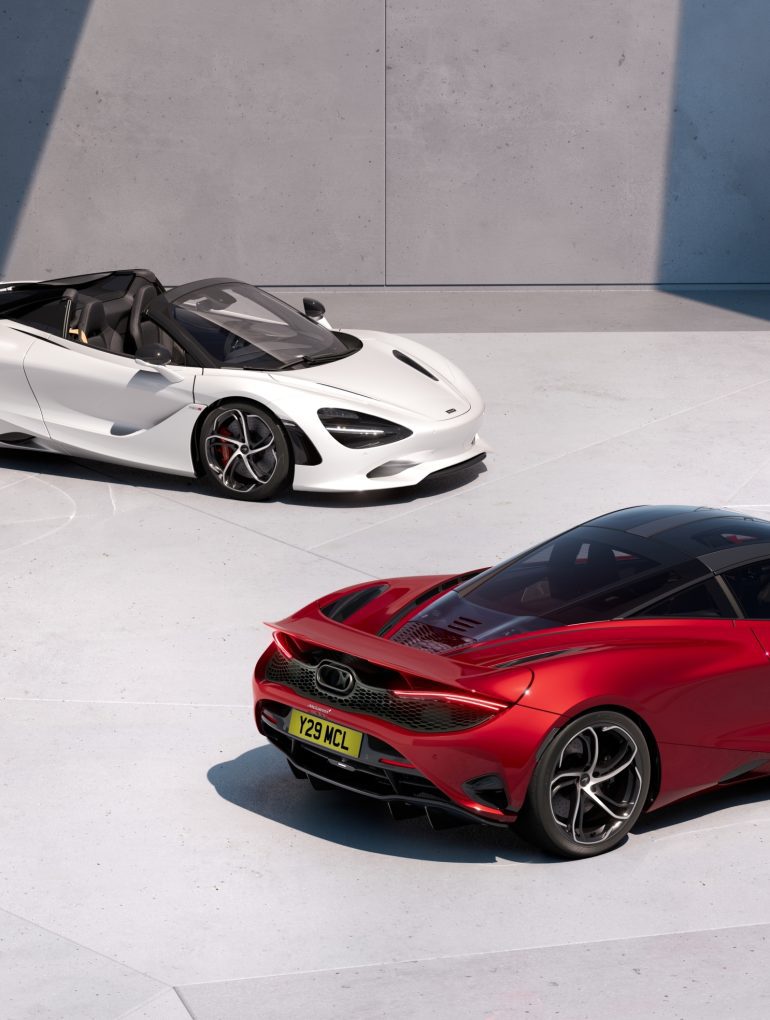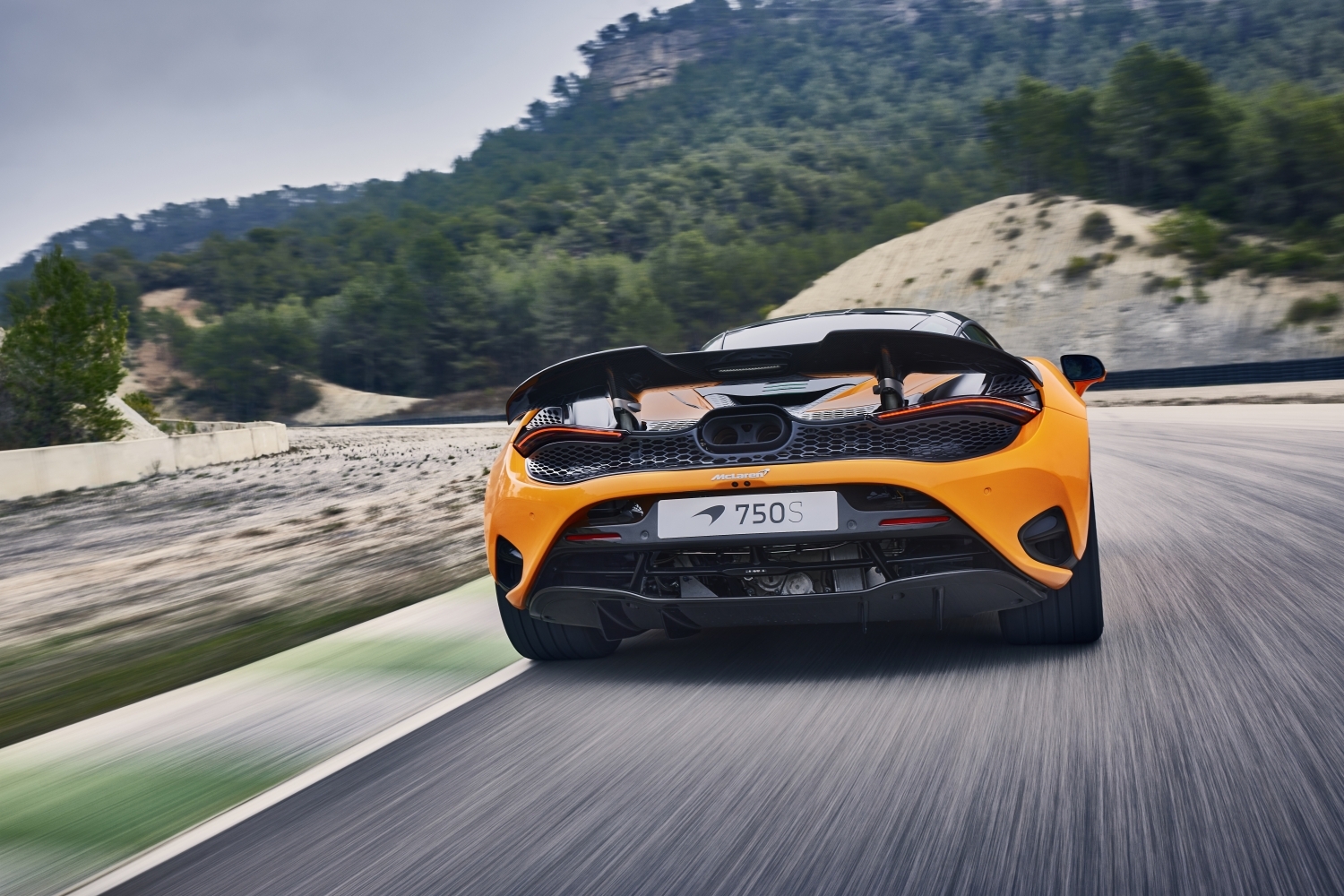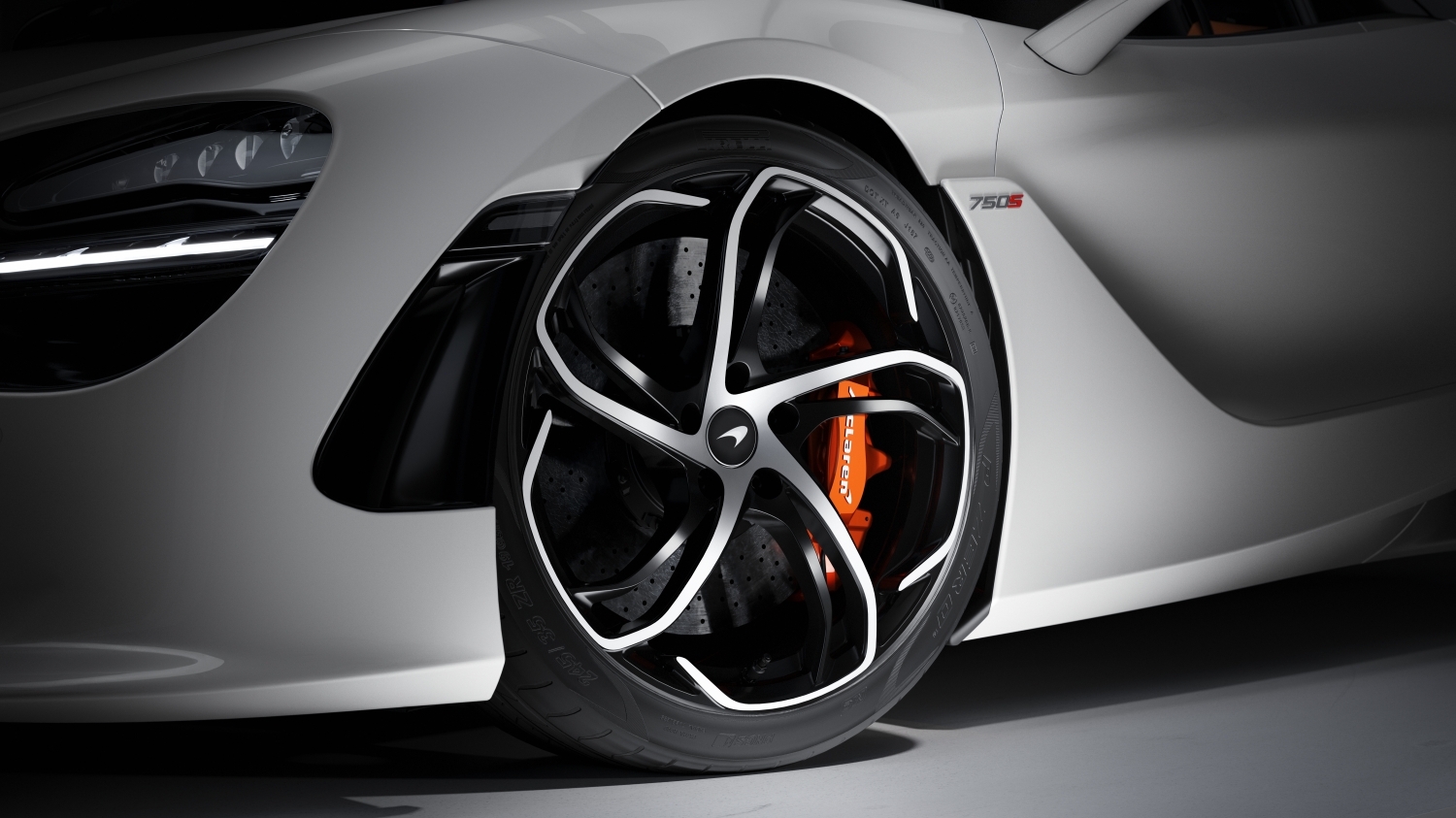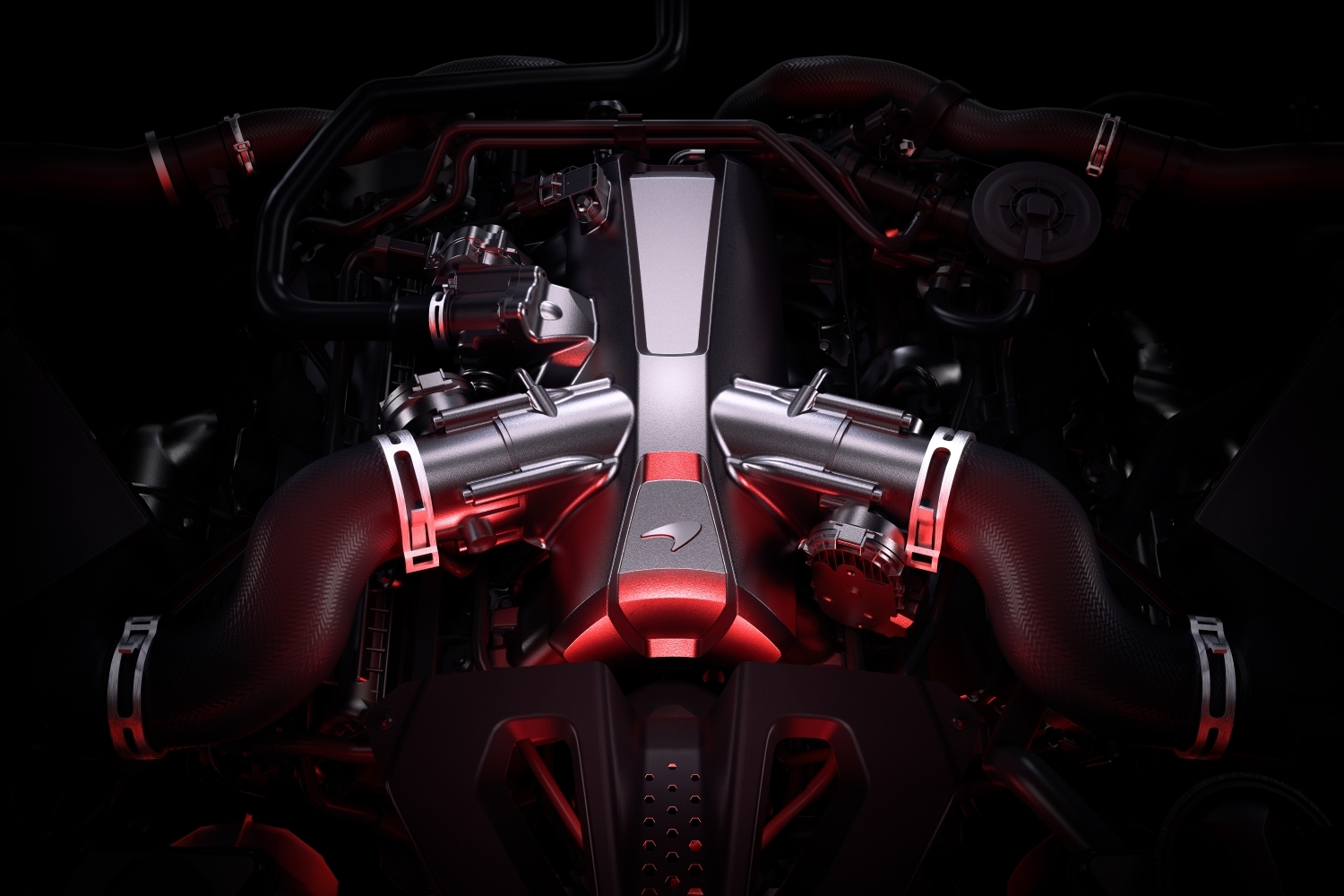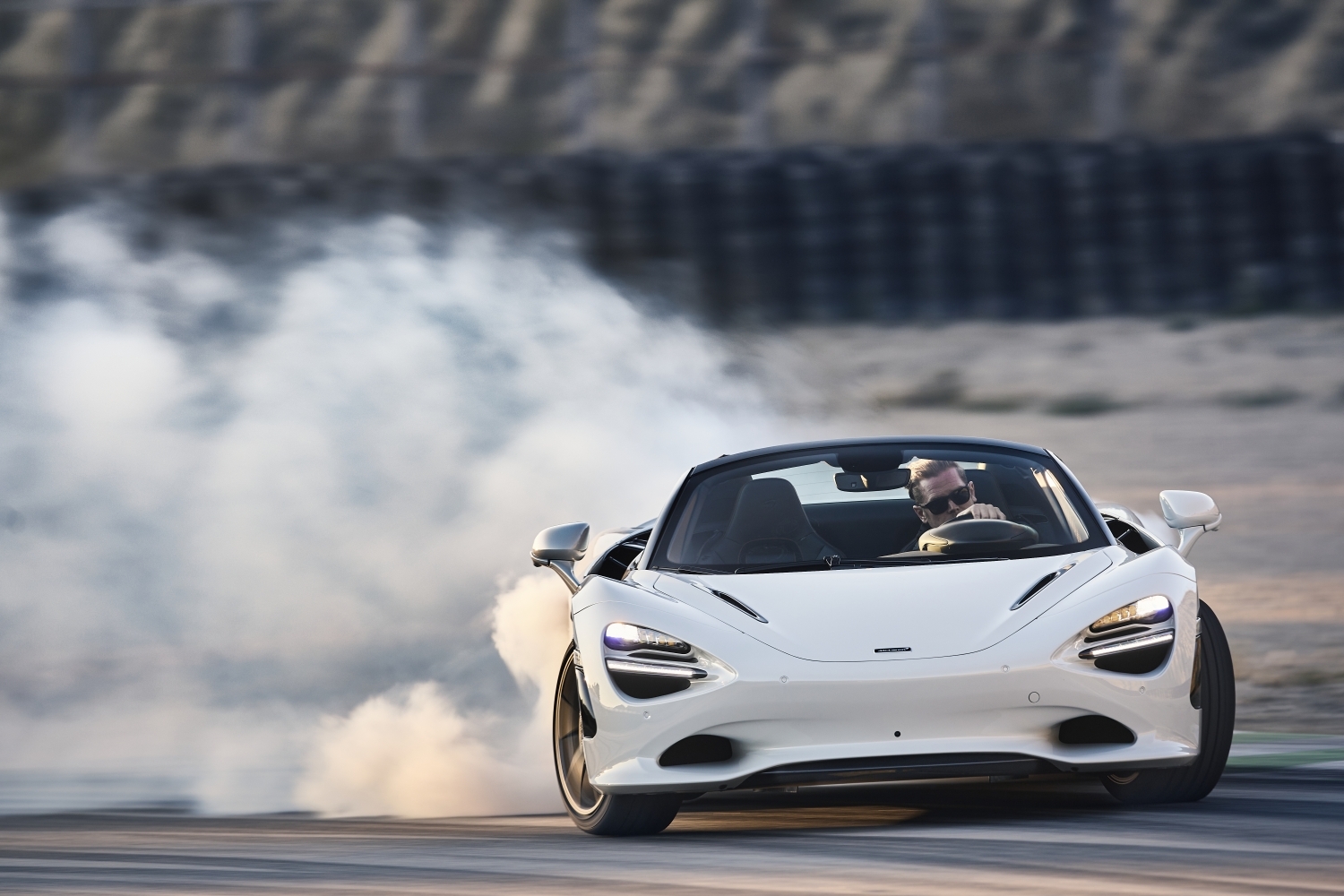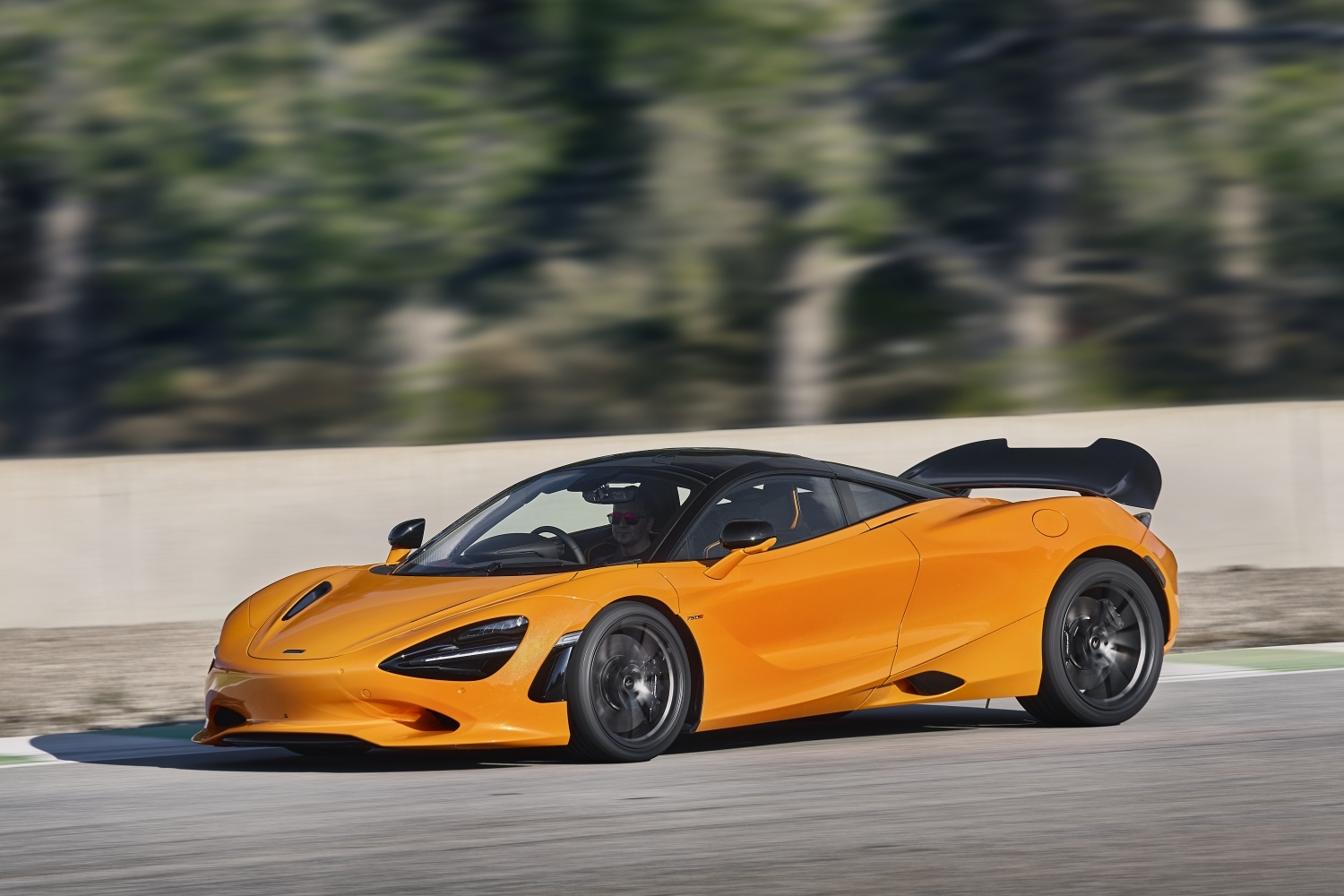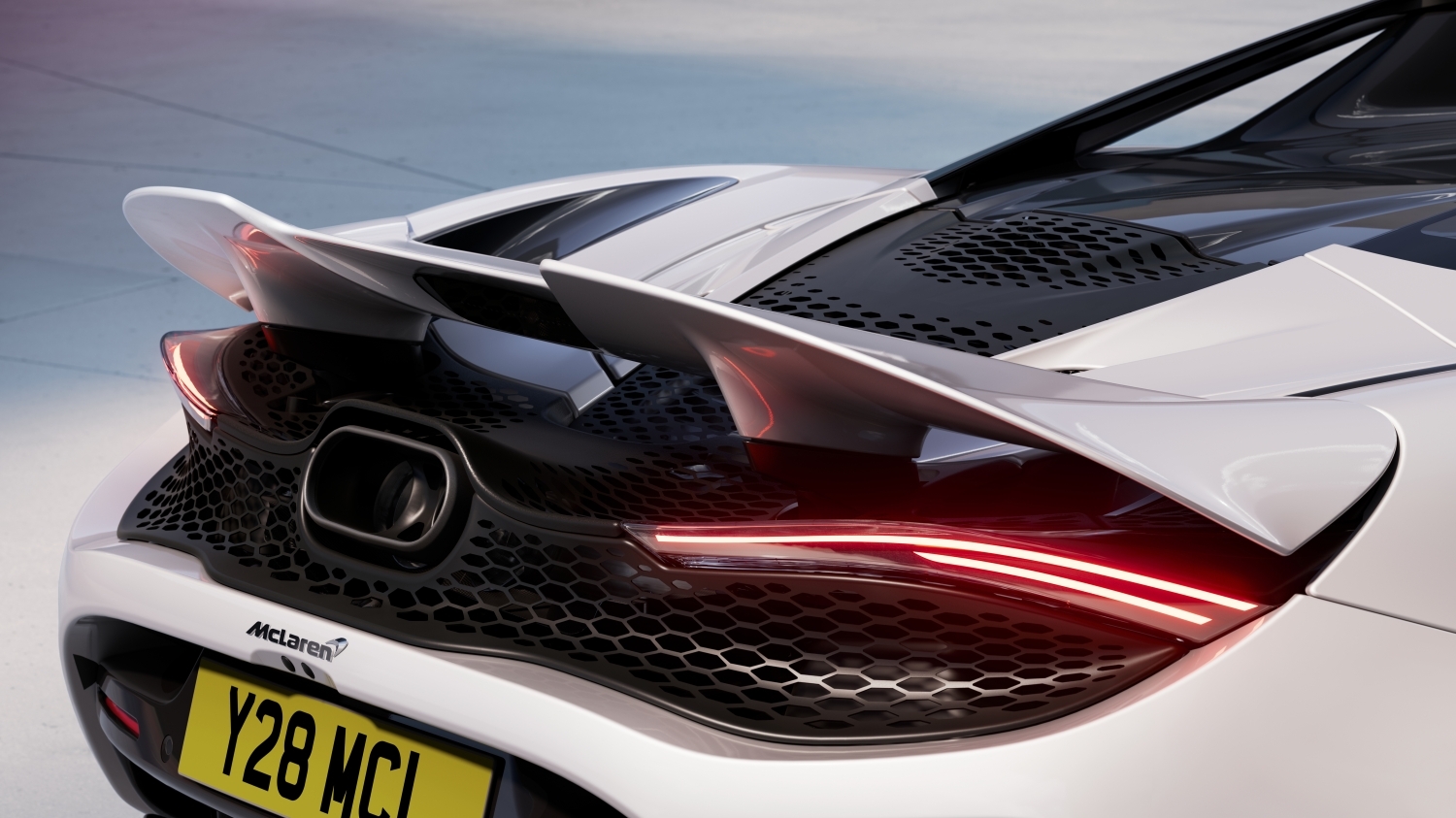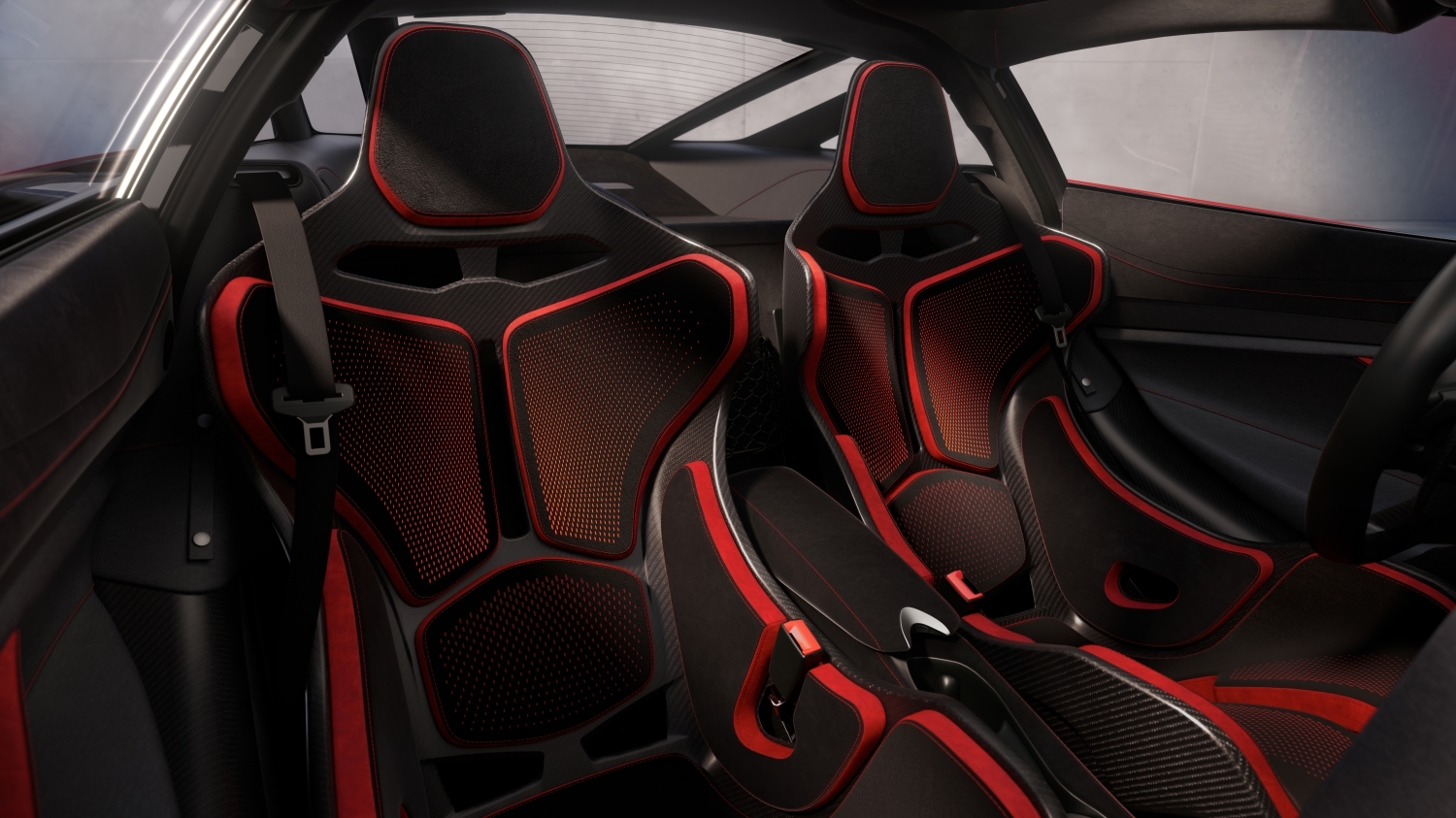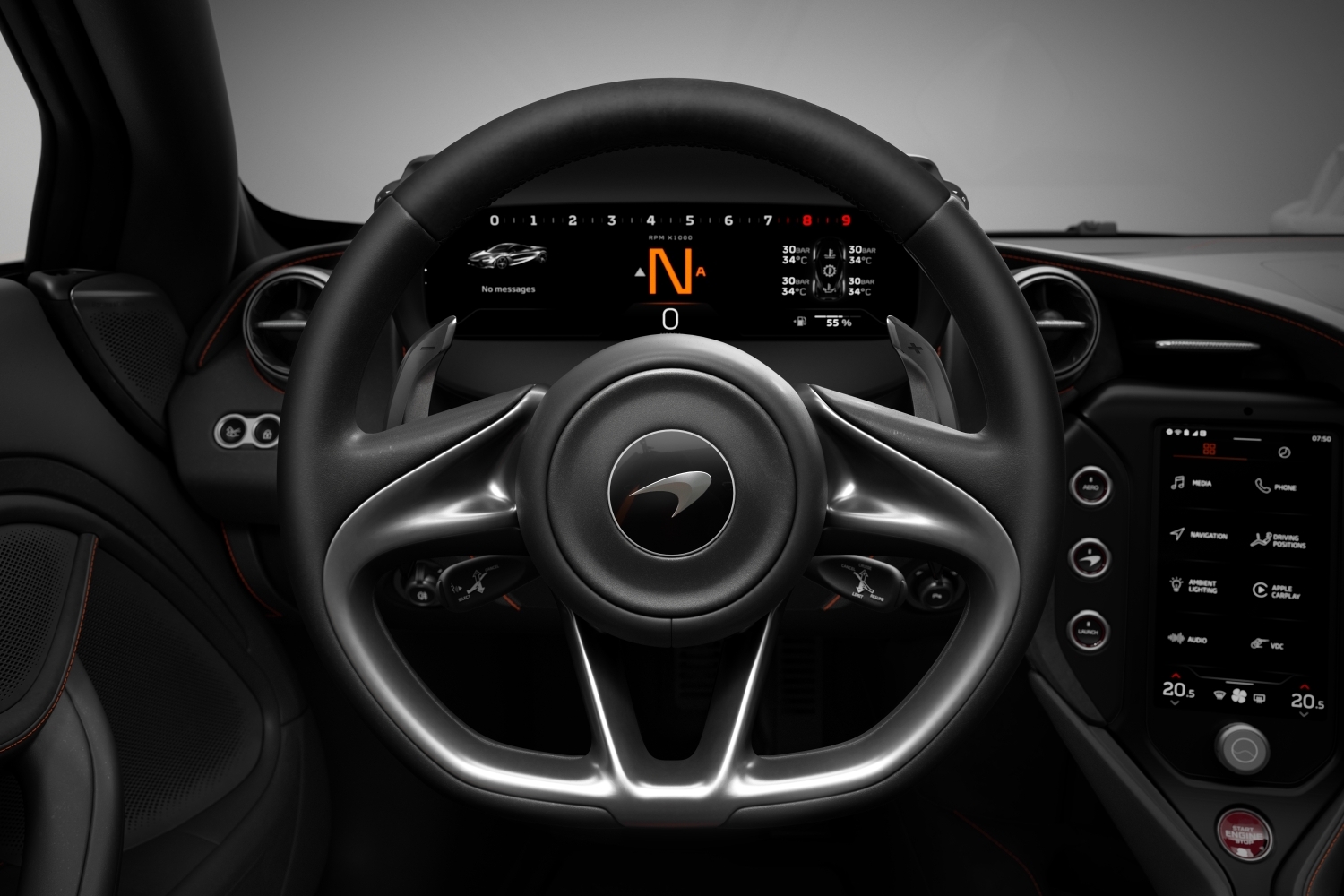McLaren Automotive today has announced the replacement for the already legendary 720S, the 2024 McLaren 750S. In comparison to its progenitor, it is at least 66 lbs lighter, and as the name suggests, gains 30 HP, bringing it to 740 HP.
About 30 percent of the new 750S parts overall are new or updated, while the base chassis remains mostly the same. This isn’t a bad thing, as the 720S’ agility and road manners were already spectacular.
Also staying around is the 4.0L twin-turbo V8, although some of the go-faster bits inside have been updated, such as the lightweight pistons from the track-weapon 765LT being brought over to the base 750S. From the picture above, you may have also noticed that the exhaust pipes are now high and centered, which isn’t just for style points. Much like with the P1, the Senna, and the Artura, raising the pipes to a higher exit point not only allows for a deeper, more pronounced diffuser, the hot gasses interact with the airflow over the rear of the car to enhance the efficiency of the rear wing, increasing downforce.
Other bits cherry-picked from the MSO parts bin include the Senna’s ferocious 15.4 inch carbon-ceramic brakes as an option if you plan on taking the 750S to the track. The standard brakes are no slouch either, with a monoblock caliper design, a hydraulic brake booster, and a motorspors-grade vacuum pump to both increase brake feel, as well as give them a mighty bite. ABS is provided by a derivative of the 720S GT3 race car’s system, so no matter how aggressively you stomp on the brakes, it will still haul you down to a stop in very rapid fashion.
Power is still delivered only to the rear wheels, through an all new seven speed dual clutch transmission. The gearbox has a shorter final drive and a ferociously aggressive first gear ratio, which helps to catapult the 750S to 62 MPH (100 KPH) in a hair under 2.8 seconds. Also new on the transmission is a downshift optimizer, which limits downshifts that could over-rev the engine, making sure the requested downshift happens when everything is in perfect alignment. This happens in milliseconds while you’re braking for the corner ahead of you so that it feels seamless, but it both improves performance as well as engine longevity.
Perhaps the biggest new bit of the 750S is, of all things, its suspension. This newest supercar debuts the third evolution of McLaren’s linked-hydraulic Proactive Chassis Control (PCC) system, which features bespoke accumulator timings, lighter springs without losing any rebound performance, and fully revised geometry over the system in the 720S. This makes the 750S one of the nimblest and agile of the “normal” McLaren supercars, easily on par with some of the MSO special versions of years past, including the 765LT.
The 750S also features an active rear wing, which will automatically flatten out or lift up depending on a combination of steering input, throttle/brake input, and overall speed. Going down a straight at the track, you will see the wing flatten out a-la-DRS (Drag Reduction System) from motorsport, but when you stamp on the brake, the wing will flip up nearly vertical to act as an air brake. This is a system adapted from the McLaren P1 and MSO cars of recent years, showing up for the first time in a production-series McLaren.
For those that were concerned about the “Coupe first, convertible later” development cycle of most supercar brands, fret not. Both the Coupe and Spider versions of the 750S are launching side by side, with the Spider gaining a retractable hardtop that will go from raised to lowered in a hair over 10 seconds, which will also work at speeds up to 30 MPH (~50 KPH). When it’s lowered, it is hidden under a set of flying buttresses that give the car a sharp, aggressive look from the cockpit back, ensuring that absolutely everyone still knows you’re in a McLaren.
Speaking of that cockpit, it has been streamlined compared to the 720S, gaining a new center-stack-mounted massive digital touchscreen that is both more responsive and half the weight of the previous version. The 750S also gains MSO-level super lightweight carbon-shell racing seats, finished in alcantara and/or nappa leather depending on which interior package (TechLux or Performance) you select.
Of course, there will be a bespoke MSO variant in the future of the 750S, as well as an Ultimate series car based on it. Orders and deposits are now being accepted for the 750S, so when we know about those variants, rest assured that Supercars.net is where you’ll be able to find all the details you need about them!
McLaren 750S Specs & Performance
The Basics
| Engine configuration | M840T 4.0 liter (3,994cc) twin-turbocharged V8 |
| Drivetrain layout | Longitudinal mid-engined, RWD |
| Power PS (bhp/kW) | 750PS (740/552) @ 7,500 RPM |
| Torque Nm (lb ft) | 800 (590) @ 5,500rpm |
| Transmission | 7 Speed Seamlesss Shift Gearbox (SSG). Comfort, Sport and Track modes |
| Steering | Electro-hydraulic; power-assisted |
| Chassis | Carbon fibre Monocage II monocoque with aluminium front and rear crash structures |
| Suspension | Independent adaptive dampers, dual aluminium wishbones, hydraulically linked PCC III system. Comfort, Sport and Track modes |
| Brakes | Carbon Ceramic Discs (390mm front; 380mm rear) with aluminium brake calipers (6-piston front; 4-piston rear) |
| Wheels (inches) | Front: 19 x 9J; Rear: 20 x 11J |
| Tyres |
Pirelli P-ZERO™ standard. Pirelli P-ZERO™ Corsa and P-ZERO™ Trofeo R available as options. Front: 245/35/R19 93Y (XL) Rear: 305/30/R20 103Y (XL) |
| Length, mm (inches) | 4,569 (180) |
| Wheelbase, mm (inches) | 2,670 (105) |
| Height, mm (inches) | 1,196 (47) |
| Width, with mirrors, mm (inches) | 2,161 (85) |
| Width, mirrors folded, mm (inches) | 2,059 (81) |
| Width, without mirrors, mm (inches) | 1,930 (76) |
| Track (to contact patch centre), mm (inches) | Front: 1,680 (66); Rear: 1,629 (64) |
| Lightest dry weight coupe, kg (lbs) | 1,277 (2,815) |
| DIN Kerb weight coupe [fluids + 90% fuel], kg (lbs) | 1,389 (3,062) |
| Lightest dry weight spider, kg (lbs) | 1,326 (2,923) |
| DIN Kerb weight spider [fluids + 90% fuel], kg (lbs) | 1,438 (3,170) |
| Fuel tank capacity, litres (UK/USA gallons) | 72 (15.8/19) |
| Luggage capacity coupe, litres | Front: 150 Rear: 210 |
| Luggage capacity spider, liters | Front: 150 Rear: 58 |
Performance Data:
| 0-97km/h (0-60mph) – coupe and Spider | 2.7 seconds |
| 0-100km/h (0-62mph) – coupe and Spider | 2.8 seconds |
| 0-200km/h (0-124mph) – coupe | 7.2 seconds |
| 0-200km/h (0-124mph) – Spider | 7.3 seconds |
| 0-300km/h (0-186mph) – coupe | 19.8 seconds |
| 0-300km/h (0-186mph) – Spider | 20.4 seconds |
| 0-400m / ¼ mile – coupe | 10.1 seconds |
| 0-400m / ¼ mile – Spider | 10.3 seconds |
| Maximum speed – coupe and Spider | 332 km/h (206 mph) |
| 200-0km/h (124mph-0) braking, metres (ft) – coupe and Spider | 113 (371) |
| 100-0km/h (62mph-0) braking, metres (ft) – coupe and Spider | 30.0 (98.0) |
Efficiency Data:
| CO2 emissions, g/km WLTP EU (combined) – coupe and Spider | 276 |
|
Fuel consumption, WTLP EU I/100km (UK MPG) |
|
| Combined – coupe and Spider | 12.2 (23.2) |
|
Fuel consumption, Federal/United States mpg |
|
| City – coupe and Spider | TBD |
| Highway – coupe and Spider | TBD |
| Combined – coupe and Spider | TBD |


